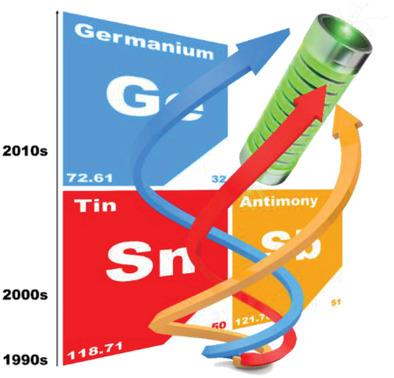当前位置:
X-MOL 学术
›
Small Methods
›
论文详情
Our official English website, www.x-mol.net, welcomes your
feedback! (Note: you will need to create a separate account there.)
A Chronicle Review of Nonsilicon (Sn, Sb, Ge)‐Based Lithium/Sodium‐Ion Battery Alloying Anodes
Small Methods ( IF 10.7 ) Pub Date : 2020-05-11 , DOI: 10.1002/smtd.202000218 Suzhe Liang 1, 2 , Ya‐Jun Cheng 2, 3 , Jin Zhu 2 , Yonggao Xia 2, 4 , Peter Müller‐Buschbaum 1, 5
Small Methods ( IF 10.7 ) Pub Date : 2020-05-11 , DOI: 10.1002/smtd.202000218 Suzhe Liang 1, 2 , Ya‐Jun Cheng 2, 3 , Jin Zhu 2 , Yonggao Xia 2, 4 , Peter Müller‐Buschbaum 1, 5
Affiliation

|
Since the commercialization of lithium‐ion batteries (LIBs) in the early 1990s, tin (Sn), antimony (Sb), and germanium (Ge)‐based anodes have attracted considerable research interest as promising candidates for next‐generation LIBs due to their high theoretical capacities, suitable operating voltages, and natural abundance. Additionally, the awareness of limited global lithium sources promoted the renaissance of sodium‐ion batteries (SIBs) in recent years. Sn, Sb, and Ge can electrochemically alloy with sodium and are regarded as promising anode candidates for high‐performance SIBs. However, these alloying/dealloying anodes suffer severe volume expansion during lithiation or sodiation processes, which is one of the biggest obstacles toward practical applications. In order to solve this problem, several strategies are developed including reducing the absolute size of particles, creating interior void space, and introducing buffer media. After more than two decades' efforts, the electrochemical performance of Sn, Sb, and Ge‐based anodes is significantly improved. Considerable studies about Sn, Sb, and Ge‐based anodes are summarized in a chronicle perspective and the brief development histories of the three anodes are outlined. With this unique review, light will be shed on the future trends of the studies on the Sn, Sb, and Ge‐based anodes for advanced rechargeable batteries.
中文翻译:

编年史回顾非硅(Sn,Sb,Ge)基锂/钠离子电池合金阳极
自1990年代初锂离子电池(LIB)商业化以来,基于锡(Sn),锑(Sb)和锗(Ge)的负极作为下一代LIB的有前途的候选者已引起了广泛的研究兴趣。高理论容量,合适的工作电压和自然丰度。此外,近年来,全球锂资源有限的认识促进了钠离子电池(SIB)的复兴。Sn,Sb和Ge可以与钠进行电化学合金化,被认为是高性能SIB的有希望的阳极候选物。然而,这些合金化/脱合金阳极在锂化或钠化过程中遭受严重的体积膨胀,这是实际应用中的最大障碍之一。为了解决这个问题,开发了几种策略,包括减小粒子的绝对大小,创建内部空隙空间以及引入缓冲介质。经过二十多年的努力,Sn,Sb和Ge基阳极的电化学性能得到了显着改善。从历史的角度总结了有关Sn,Sb和Ge阳极的大量研究,并概述了这三个阳极的简要发展历史。通过这次独特的回顾,将为高级可充电电池的Sn,Sb和Ge负极研究的未来趋势提供启示。从历史的角度总结了基于Ge和Ge的阳极,并概述了这三个阳极的简要发展历史。通过这次独特的回顾,将为高级可充电电池的Sn,Sb和Ge负极研究的未来趋势提供启示。从历史的角度总结了基于Ge和Ge的阳极,并概述了这三个阳极的简要发展历史。通过这次独特的回顾,将为高级可充电电池的Sn,Sb和Ge负极研究的未来趋势提供启示。
更新日期:2020-05-11
中文翻译:

编年史回顾非硅(Sn,Sb,Ge)基锂/钠离子电池合金阳极
自1990年代初锂离子电池(LIB)商业化以来,基于锡(Sn),锑(Sb)和锗(Ge)的负极作为下一代LIB的有前途的候选者已引起了广泛的研究兴趣。高理论容量,合适的工作电压和自然丰度。此外,近年来,全球锂资源有限的认识促进了钠离子电池(SIB)的复兴。Sn,Sb和Ge可以与钠进行电化学合金化,被认为是高性能SIB的有希望的阳极候选物。然而,这些合金化/脱合金阳极在锂化或钠化过程中遭受严重的体积膨胀,这是实际应用中的最大障碍之一。为了解决这个问题,开发了几种策略,包括减小粒子的绝对大小,创建内部空隙空间以及引入缓冲介质。经过二十多年的努力,Sn,Sb和Ge基阳极的电化学性能得到了显着改善。从历史的角度总结了有关Sn,Sb和Ge阳极的大量研究,并概述了这三个阳极的简要发展历史。通过这次独特的回顾,将为高级可充电电池的Sn,Sb和Ge负极研究的未来趋势提供启示。从历史的角度总结了基于Ge和Ge的阳极,并概述了这三个阳极的简要发展历史。通过这次独特的回顾,将为高级可充电电池的Sn,Sb和Ge负极研究的未来趋势提供启示。从历史的角度总结了基于Ge和Ge的阳极,并概述了这三个阳极的简要发展历史。通过这次独特的回顾,将为高级可充电电池的Sn,Sb和Ge负极研究的未来趋势提供启示。











































 京公网安备 11010802027423号
京公网安备 11010802027423号